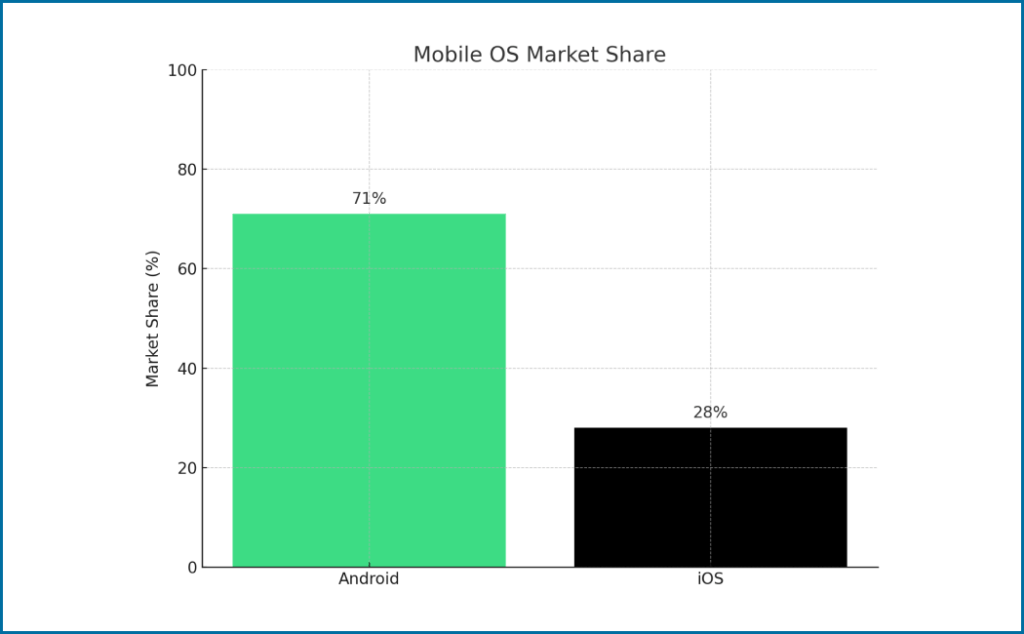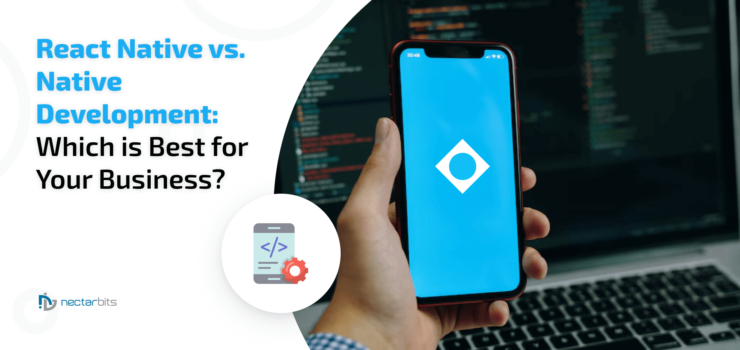Quick summary: The app development approach- React Native or native development plays a vital role in making the app successful. Identifying the best development approach is possible with a detailed overview and one-to-one comparison of both React Native and native development. This blog will explain everything in detail that helps make the best decision.
Let’s accept it: Building an app for two major platforms- Android and iOS has become essential for businesses to widen their market reach, optimize revenue, improve user accessibility, and its competitive necessity. Android holds nearly 71% market share and iOS
holds a 28% market share, which means building an app for the two platforms helps maximize visibility and downloads.

The choice of app development follows the strategic business decision to build an app for both platforms initially, that’s native development or cross-platform development using frameworks like- React Native or Xamarin. According to market trends, some businesses opt for native development while others turn towards a cross-platform framework- React Native to reap the benefits it provides.
However, if, as an entrepreneur, you are unsure about which way to choose, the comparison of React Native app development and native development will help you. Let’s explore through head-to-head comparison to identify which is the best fit for your business.
One-to-one comparison of React Native and native development
The thorough comparison of React Native and native development based on significant factors reveals which development approach allows businesses to shape their vision into reality. Let’s dive in!
Development time- it’s money, after all.
The mobile app development time is critical for businesses that need applications in reduced time. That’s where the development approach plays a unique role. For example, building native apps for both- Android and iOS platforms requires developers to make two different apps using different technology stacks and write hundreds of lines of code separately. When the code is modified and implemented, every time, the app is executed independently. This way, the time to build and modify an app gets doubled.
With React Native development, the developers create an app that works on both platforms- iOS and Android using the same codebase. There’s a hot reloading feature that enables previewing changes in the app in real-time without reloading. The rapid development and iteration reduce development time and modification.
Result: React Native enables building an app in minimum time rather than native development.
Development cost- it’s universally questioned.
The development cost is the basic criteria that every business considers before heading to the app development because it keeps them financially sound. With React Native development, cross-platform compatibility reduces the number of hours that developers invest in app development and the resources required, which ultimately minimizes the development cost. Businesses will get an app wrapped in a container for multiple platforms at the expense of one app development.
Native development means building an app for different platforms using native languages, APIs, and programming that enables access to a range of devices. The extensive customization, code maintenance, and continuous upgrades make the app development resource-intensive, which increases the app development cost.
Result: Native development is costly as compared to React Native development.
UI/UX design- usability and experience matter a ton.
The phenomenal user experience is directly connected with UI/UX design as it creates a long-lasting impression on the users at first glance. Native development allows the creation of pixel-perfect designs tuned for each platform with complete control over UI elements and delivers a native look and feel. Platform-specific UI/UX design is more responsive and intuitive and seamlessly integrates with platform tools.
React Native framework ensures custom design but requires a native module and delivers a look and feel closer to native development. It facilitates platform adaptability with conditional rendering, gesture handling with supported libraries and decent animation, but performance lags are expected. Also, heavy UI elements need optimization and touch responsiveness in complex UI is slightly delayed.
Result: Native development delivers the best user experience with custom UI/UX design.
App performance must be superior.
When the app loading time takes more than 3 seconds, the users take no time to leave the app. With native app development, superior performance is guaranteed with a stable frame rate, 60 FPS maintenance, and native lists. Optimized memory footprint, high CPU efficiency, and no bridge or communication overheads contribute to high loading speed.
When businesses need high performance and some trade-offs are accepted, then React Native is considered. React Native ensures excellent performance with careful tuning through virtualization, native modules for background tasks, and garbage collection management by the JS engine.
Result: Native development delivers the best performance as opposed to React Native development.
Support for third-party integrations
Third-party integrations reduce development time and cost because they eliminate the need to build functionalities from scratch and plug and play seamlessly. Native development provides access to all platform SDKs, supports modern SDKs, and exposes full capabilities per platform. This way, popular SDKs and APIs are easily integrated with stable updates and long-term support guaranteed.
On the other hand, with React Native development, limited SDKs are integrated using JS bindings, custom SDK integration requires native bridge writing, and manual linking is needed when complexity is involved in native modules integration. Also, only popular native modules and APIs are supported, and custom plugin creation requires knowledge of both native and JS code.
Result: Native development provides better support for third-party integrations.
Security is difficult to overlook
Security is always prioritized for app development to ensure users’ data remains intact and business reputation is not damaged. Native development provides access to secure storage options with full access to Keychain for iOS app development and Keystore for Android development. Secure implementation of an encrypted database ensures data remains safe at rest and in transit.
React Native requires native modules for data storage security, manual configuration for network security, enables secure authentication with supported plugins, and ensures the app is compliant with regulations, but careful handling is a must.
Result: The security offered by native apps is incomparable.
Which is better- React Native vs. Native Development?
In the debate- React Native vs. Native Development, declaring a universal winner is implausible as each development approach has its strengths and weaknesses. Native app development is a good choice when you want to build complex apps, need regular updates, user experience is a priority, and native device features access is required. On the contrary, React Native development is preferred when businesses want to launch apps on multiple platforms at the cost and time of one app development. Building simple apps with React Native helps in getting an earlier entry into the market.
It concludes that the decision for the development approach- native development and React Native development rests on the business app development requirements. Enter the mobile realm using the right development approach.
Conclusion
The goal of mobile app development is to meet business digital needs, deliver the best user experience, fulfil performance standards, and scale with business growth. The app development approach- React Native and native development allow businesses to achieve their goals, but they should be selected based on business app development needs, budget, and timeline.If you are unsure which development method fits well with your app development project, connect with a reliable mobile app development company in India that helps you know which development approach- native development or React Native app development is better for your future application. Talk with them!

FAQs
React Native framework allows developers to build applications for two or more platforms using the same codebase. On the contrary, with native development, developers use separate tech stacks for creating an app for a specific platform.
If rapid app development is your requirement, React Native is the best development approach to choose because it enables using a single codebase for both platforms and facilitates rapid testing with hot reloading.
Certainly, React Native development is the cost-effective approach because it’s built using fewer resources and consuming fewer development hours. Additionally, lower maintenance cost makes it inexpensive as compared to native development.
Typically, start-ups leverage the React Native framework to build MVP or business apps with standard UI/UX design.
Businesses should consider budget, timeline, app’s complexity, and long-term goals for choosing native development or React Native development.








